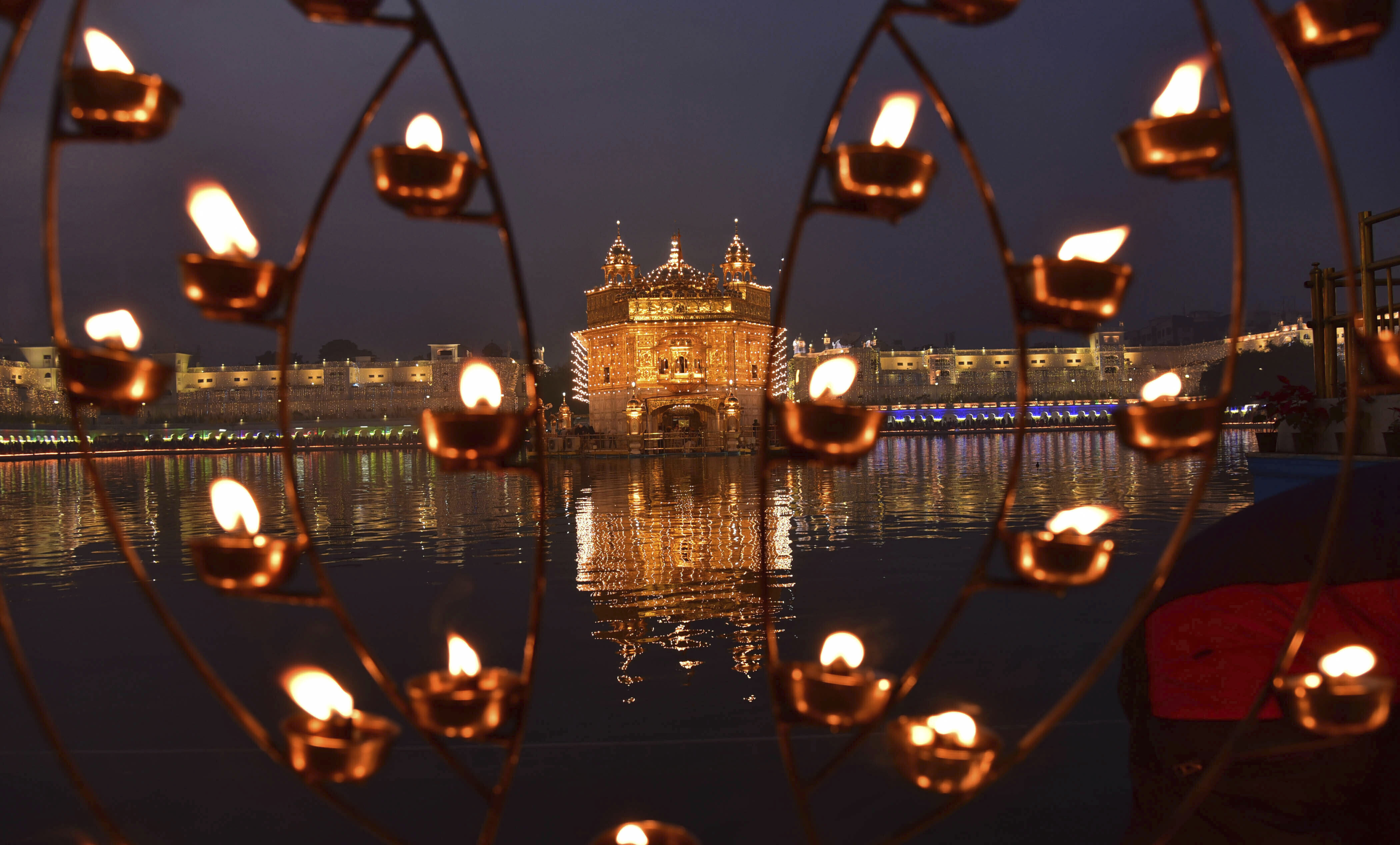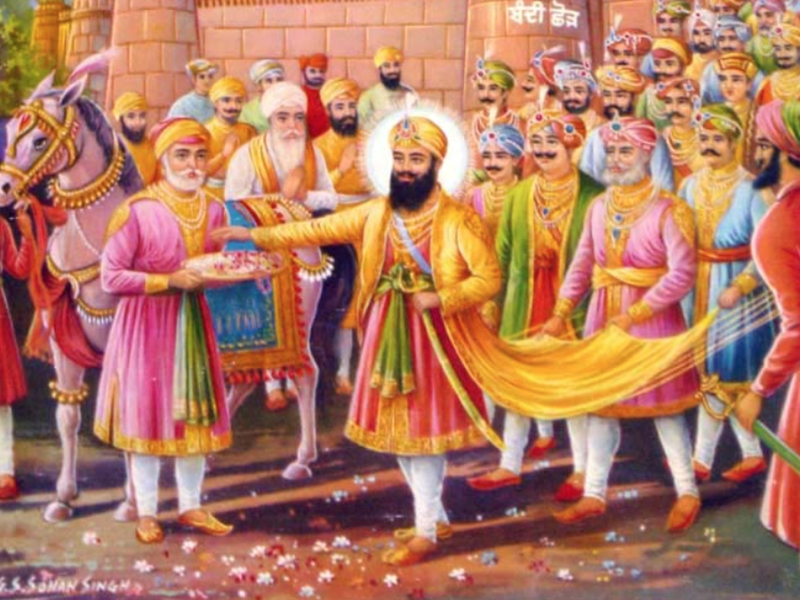(RNS) — As Hindus celebrate Diwali beginning Sunday (Nov. 12), the Sikh world will observe Bandi Chhor Divas, two distinct festivals that are always celebrated together in October or November, depending on the shifts of the lunar calendar. But while Diwali is a festival honoring the goddess of prosperity and good fortune, Sikhs on this day are encouraged to think about freedom and justice.
The story of Bandi Chhor Divas and its link to Diwali goes back to the early 17th century, when Guru Hargobind, the sixth Sikh guru, became the leader of the faith at the age of 11, as his father, Guru Arjan, was imprisoned by Emperor Jahangir, the ruler of India at the time, who was concerned about the growing popularity of the Sikh faith.
When Jahangir executed Guru Arjan soon afterward, Guru Hargobind recognized that Sikhs could no longer take their freedom nor their right to practice their faith for granted. He resolved to strengthen his fellow Sikhs against tyranny and oppression.
Guru Hargobind became known as the king of both spiritual and worldly affairs, setting the example that to rule justly, one must be dedicated to a spiritual practice; only then can temporal authority be possible. He established the Akal Takhat, still the seat of Sikh temporal authority in Amritsar, the center of Sikh life in the Indian state of Punjab. The Akal Takhat sits opposite the Harmandir Sahib, the faith’s holiest site, and together they physically represent the concept of Miri and Piri — the worldly and saintly realms. Guru Hargobind wore two swords to symbolize his rule over both.
The epitome of righteousness, the young guru realized he was being closely observed by the emperor and his people. They considered him to be a magnetic personality, attracting all those who desired equality and those who supported a leader dedicated to upholding the principles of justice and freedom. This concerned the emperor, who worried that he may be losing control over his subjects, as they flocked to Guru Hargobind’s message of empowerment and moral authority. The Indian imperial court also grew concerned as the guru raised an army and raised horses.
When the emperor fell gravely ill, a conniving assistant devised a plan to dethrone Guru Hargobind and separate him from his followers. He convinced the court astrologers to proclaim that the only way that the emperor would recover would be if a holy man prayed for him and if the holy man submitted to imprisonment in the Gwalior Fort, where enemies of the state were detained and often died.
The guru was duly summoned and directed by the emperor to report to Gwalior Fort or face death. The guru agreed to be imprisoned along with 52 other princes of local neighboring states who had spoken out against the emperor’s policies.
During his time in the fort, Guru Hargobind became his fellow prisoners’ mentor, uplifting their spirits by leading them in daily meditation. Months after the emperor had recovered from his malady, an admirer of the guru convinced Emperor Jehangir to release him. But Guru Hargobind replied that he could not embrace his good fortune at the expense of other prisoners, refusing to leave the fort unless all of the other 52 princes were freed with him.
The message was relayed back to Emperor Jehangir who then countered to the Guru, “You may be released from the fort and take as many other prisoners as can hold on to your robe.” The emperor, sure only a handful would be able to accompany him, thought he had outwitted the guru. But Guru Hargobind had arranged for a special robe to be made with 52 coattails. Each of the prisoners grasped a panel of the robe and walked to freedom along with the great guru. With much fanfare, they returned to Amritsar just as the festival of Diwali was being celebrated.

Lamps lit by devotees shine in front of the illuminated Golden Temple, the holiest of Sikh shrines, in Amritsar, India, Tuesday, Nov. 12, 2019. (AP Photo/Prabhjot Gill)
Since then, Guru Hargobind has been known as Bandi Chhor — liberator of the imprisoned — and Sikhs have celebrated the day of Diwali as Bandi Chhor Divas, the day of freedom and liberation. It is symbolic of righteousness and the triumph of justice, along with the victory of truth and morality over oppression and tyranny.
While Bandi Chhor Divas is about remembering our past, it’s also about how we aim to live today. It reminds us to uphold the values of freedom, equality and compassion. It reminds us to stand up and speak out against all forms of injustice wherever they may occur. These values were imbued in the Sikh faith by its founding guru, Guru Nanak, exemplified by Guru Hargobind and actualized by Guru Gobind Singh, who instituted the idea of Sikhs as saint-soldiers. We reflect daily on the Sikh approach to justice, “Sarbatt da Bhalla,” which means “for the upliftment of all.”
Sikhs honor Guru Hargobind’s memory by putting these values into practice, but people of all backgrounds may adopt them, too. As our world is engulfed in cruelty and suffering, what are we doing to reduce people’s pain?
The holiday reminds me to live into the example of Guru Hargobind by recommitting to calling out bigotry and hate speech, no matter who it’s targeting or who is saying it. I recommit to being an upstander, not a bystander, so that when injustice occurs, I feel empowered to address it in whatever way I can.
Being just in a difficult situation, and believing in the sacredness of human life, as Guru Hargobind did, can be as simple as being kind and compassionate to everyone I encounter. It’s an idea we can all practice — and one that feels sorely needed in our world today. If only leaders of nation-states could learn to do this, perhaps there would be less conflict in our world.
On Bandi Chhor Divas, I’m hoping people the world over will learn and grow so we can build a more just world together.
(Sandeep Singh, director of the Sikh Academy for Gurmat Education in Oakland, New Jersey, has been teaching Sikh youth in the New York area for more than 20 years. The views expressed in this commentary do not necessarily reflect those of Religion News Service.)





